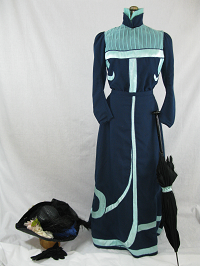1897
A braid of satin put on cloth (wool) was greatly in favor for winter in 1897. The more elaborate the pattern the better. This gown of dark blue smooth faced cloth is noticeably smart and the lines of satin taffeta trimming are designed to flow pleasingly down the front and toward the back. The pattern is carried out on the waist. The sleeves and the square epaulettes over the top of the sleeves. The unusually deep rounded yoke is of tucked sheer silk. A high collar, with its inside frill of green, is of the cloth like the bodice. All bodices had high necks which were stiffened with boning to keep the head back and the chin out. By 1897 the bodices started to pouch in the front. Fullness has slipped into the bodice and a new chest out look developed. A large hat of fine black straw trimmed with blue and black feathers. The brim is turned up in the back showing several more roses. Parasols were long and used as walking sticks. 1890’s skirts were completely lined and had added extra stiffening and cording along the hem. Along the bottom to catch the dust was a brush braid. This collected the worst of the mud, for the skirts swept the roads however carefully you might hold them up behind. Afterwards the crusted mud had to be brushed off which might take an hour or more to do. A fashion journal warned one of the most disastrous aspects of the raised skirt is when the silk underskirt is caught higher than the transparency and reveals . . . well . . . anything there is to be revealed. The appeal of these seductive garments became audible with their suggestive frou-frou. Only a mature woman could wear the fashions of the day to advantage.
This reproduction was made by Peggy Fields based on an image in Blum 1974: 284 for Nancy Stout one of her models.
Click the image for detailed views.


